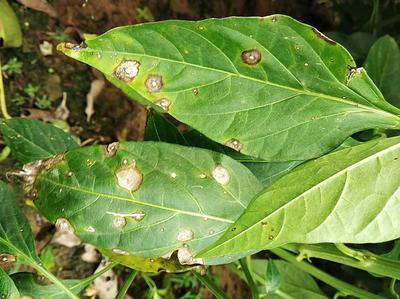
Cercosporosis
WHAT IT IS AND HOW TO ELIMINATE
Plantas decorativas de jardín y/o interior
Cercosporosis
Cercospora sp.
Pathogen:
Fungus
Type:
Risk to the plant:
HIGH
Cercosporosis

WHO CAUSES IT?
Cercospora sp. is a genus of phytopathogenic fungi widely distributed in temperate and tropical climates, responsible for various foliar diseases in a wide range of plants. These fungi are anamorphic, which means that their asexual reproduction is predominant, through the production of elongated conidia that emerge from structures called conidiophores. These structures form on the surface of infected leaves, mainly under conditions of high humidity. Conidia are easily dispersed by wind, rain splashes, or contaminated tools. Once deposited on the leaf surface, they germinate quickly if there is the presence of free water and adequate temperatures. The fungus penetrates through stomata or microwounds, colonizing intercellular tissues and destroying cells through the production of toxins and enzymes. Later, when conditions remain favorable, the fungus returns to fruit on the lesions, producing new conidial structures that perpetuate the process. In addition, it can survive between crop cycles in infected plant remains, from where it initiates new infections at the beginning of the following season.
SYMPTOMS
Cercosporosis affects various plants, especially crops such as beets, soybeans, rice, carrots, among others. The disease manifests itself mainly in the leaves, where it reduces the photosynthetic surface, weakens the general development of the plant and can cause significant economic losses if not controlled in time. The lesions begin as small chlorotic spots that evolve into necrotic areas surrounded by lighter halos, giving a characteristic mottled appearance.
Circular or irregular brown or grayish spots, yellowish halos surrounding the lesions, weakening of the leaves and premature fall, reduction in the size and quality of the fruits, progressive defoliation, general weakening of the crop, decreased yield.


DEVELOPMENT CONDITIONS
Temperature:
20°C – 30°C
Humidity:
80% – 100%
HOW IS IT SPREAD?
Wind, rain splash, contaminated tools, infected crop remains, irrigation water, contaminated seeds
HOW TO ELIMINATE IT?
Home treatments
Natural allies
There are no natural allies
Chemical treatments
RECOMMENDED PRODUCTS TO ELIMINATE THE PEST
PLANTAS REPELENTES
-
RECOMMENDATIONS
- Avoid wetting the leaves when watering; water directly to the ground.
- Leave space between plants for air to circulate.
- Eliminate diseased leaves and do not leave them on the ground.
- Rotate crops and do not always plant in the same place.
- Use healthy and good quality seeds.
- Apply horsetail infusion or a solution of baking soda and neutral soap.
- If there are already many symptoms, you can use a natural or chemical fungicide, but always follow the instructions on the container.















